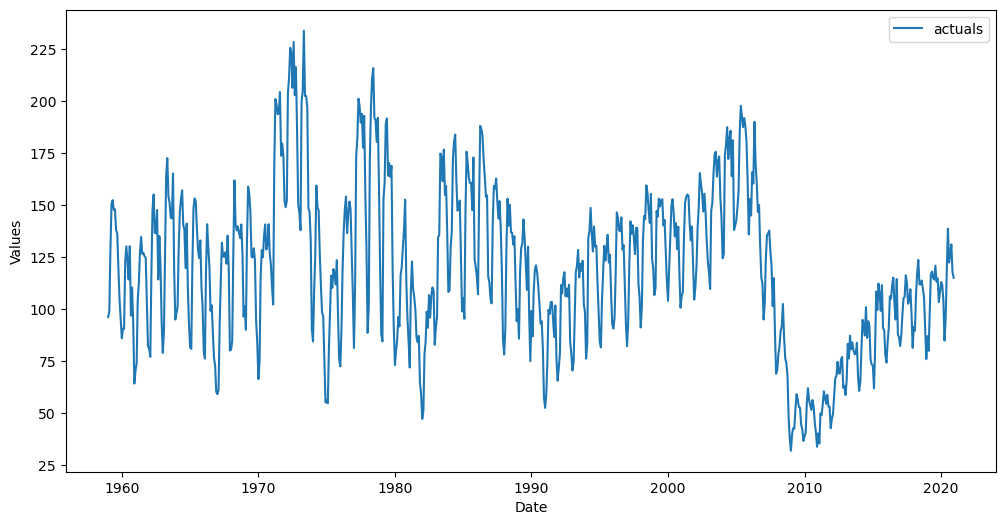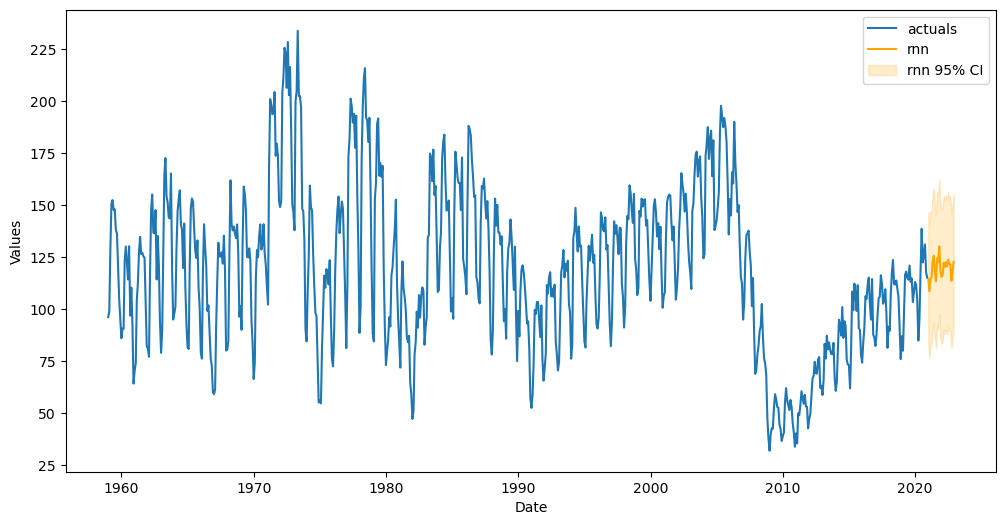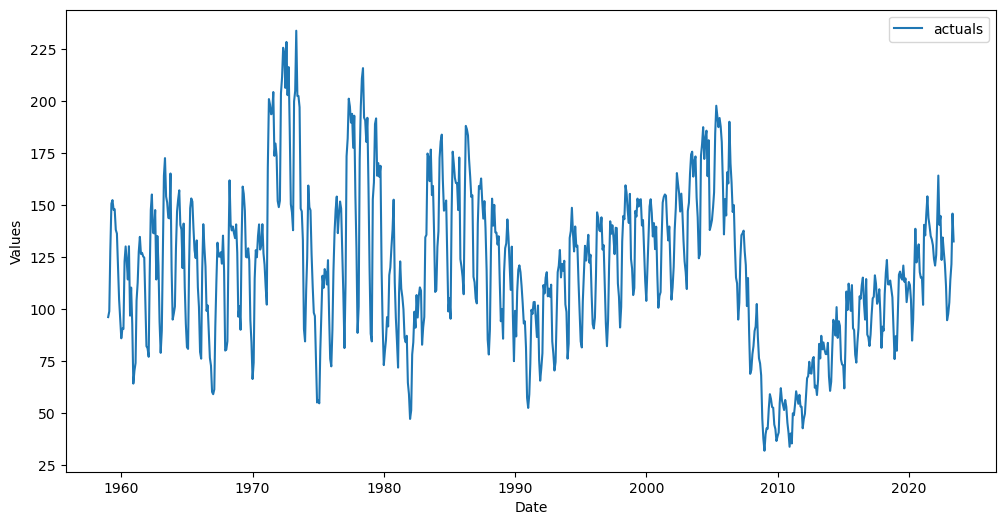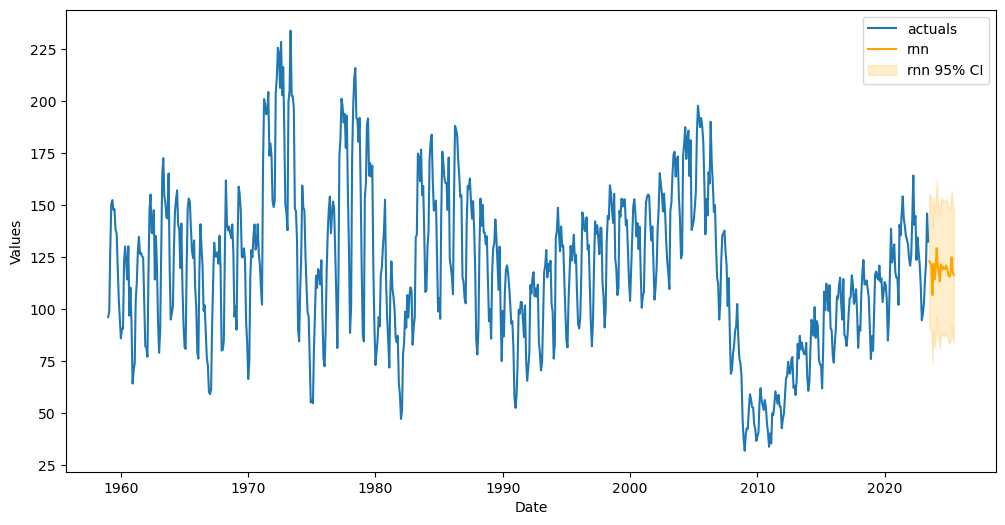Transfer Learning - TensorFlow
Transfer learning tensorflow (RNN/LSTM) models works slightly different than other model types, due to the difficulty of carrying these models in
Forecasterobject history.Forecaterobjects are meant to be be copied and pickled, both of which can fail with tensorflow models. For that reason, it is good to save out tensorflow models manually before using them to transfer learn.This notebook also demonstrates transferring confidence intervals.
Requires
>=0.19.1.
[1]:
from scalecast.Forecaster import Forecaster
from scalecast.util import infer_apply_Xvar_selection, find_optimal_transformation
from scalecast.Pipeline import Pipeline, Transformer, Reverter
from scalecast import GridGenerator
import pandas_datareader as pdr
import matplotlib.pyplot as plt
import pandas as pd
Initiate the First Forecaster Object
This series ends December, 2020.
[2]:
df = pdr.get_data_fred(
'HOUSTNSA',
start = '1959-01-01',
end = '2020-12-31',
)
df.head()
[2]:
| HOUSTNSA | |
|---|---|
| DATE | |
| 1959-01-01 | 96.2 |
| 1959-02-01 | 99.0 |
| 1959-03-01 | 127.7 |
| 1959-04-01 | 150.8 |
| 1959-05-01 | 152.5 |
[3]:
f = Forecaster(
y = df.iloc[:,0],
current_dates = df.index,
future_dates = 24,
cis=True,
test_length = 24,
)
f.plot()
plt.show()

Fit the RNN Model
[4]:
f.set_estimator('rnn')
f.manual_forecast(epochs=15,lags=24)
Epoch 1/15
21/21 [==============================] - 2s 8ms/step - loss: 0.4615
Epoch 2/15
21/21 [==============================] - 0s 9ms/step - loss: 0.3677
Epoch 3/15
21/21 [==============================] - 0s 8ms/step - loss: 0.2878
Epoch 4/15
21/21 [==============================] - 0s 8ms/step - loss: 0.2330
Epoch 5/15
21/21 [==============================] - 0s 8ms/step - loss: 0.1968
Epoch 6/15
21/21 [==============================] - 0s 8ms/step - loss: 0.1724
Epoch 7/15
21/21 [==============================] - 0s 8ms/step - loss: 0.1555
Epoch 8/15
21/21 [==============================] - 0s 7ms/step - loss: 0.1454
Epoch 9/15
21/21 [==============================] - 0s 7ms/step - loss: 0.1393
Epoch 10/15
21/21 [==============================] - 0s 8ms/step - loss: 0.1347
Epoch 11/15
21/21 [==============================] - 0s 7ms/step - loss: 0.1323
Epoch 12/15
21/21 [==============================] - 0s 7ms/step - loss: 0.1303
Epoch 13/15
21/21 [==============================] - 0s 6ms/step - loss: 0.1279
Epoch 14/15
21/21 [==============================] - 0s 7ms/step - loss: 0.1275
Epoch 15/15
21/21 [==============================] - 0s 7ms/step - loss: 0.1261
1/1 [==============================] - 0s 345ms/step
Epoch 1/15
22/22 [==============================] - 2s 8ms/step - loss: 0.3696
Epoch 2/15
22/22 [==============================] - 0s 7ms/step - loss: 0.3072
Epoch 3/15
22/22 [==============================] - 0s 6ms/step - loss: 0.2600
Epoch 4/15
22/22 [==============================] - 0s 6ms/step - loss: 0.2255
Epoch 5/15
22/22 [==============================] - 0s 6ms/step - loss: 0.2014
Epoch 6/15
22/22 [==============================] - 0s 6ms/step - loss: 0.1840
Epoch 7/15
22/22 [==============================] - 0s 5ms/step - loss: 0.1713
Epoch 8/15
22/22 [==============================] - 0s 5ms/step - loss: 0.1616
Epoch 9/15
22/22 [==============================] - 0s 5ms/step - loss: 0.1557
Epoch 10/15
22/22 [==============================] - 0s 5ms/step - loss: 0.1503
Epoch 11/15
22/22 [==============================] - 0s 5ms/step - loss: 0.1437
Epoch 12/15
22/22 [==============================] - 0s 6ms/step - loss: 0.1404
Epoch 13/15
22/22 [==============================] - 0s 5ms/step - loss: 0.1381
Epoch 14/15
22/22 [==============================] - 0s 6ms/step - loss: 0.1354
Epoch 15/15
22/22 [==============================] - 0s 6ms/step - loss: 0.1339
1/1 [==============================] - 0s 327ms/step
22/22 [==============================] - 0s 3ms/step
[5]:
f.plot(ci=True)
plt.show()

Save the model out
After you fit a tensforflow model, the fit model is attached to the Forecaster in the tf_model attribute. You can view the model summary:
[6]:
f.tf_model.summary()
Model: "sequential_1"
_________________________________________________________________
Layer (type) Output Shape Param #
=================================================================
simple_rnn_1 (SimpleRNN) (None, 8) 80
dense_1 (Dense) (None, 24) 216
=================================================================
Total params: 296
Trainable params: 296
Non-trainable params: 0
_________________________________________________________________
However, immediately after changing estimators or when the object is pickled out, this attribute is lost. Therefore, it is a good idea to save the model out:
[7]:
f.save_tf_model(name='model.h5') # default argument
Later, when you want to transfer learn with the model, you can re-attach it to the Forecaster object:
[8]:
f.load_tf_model(name='model.h5') # default argument
This re-attaches the tf_model attribute.
Initiate the Second Forecaster Object
Later, if we have more data streaming in, instead of refitting a model, we can use the already-fitted model to make the predictions. This updated series is through June, 2023
You can use an updated version of the original series, you can use the same series with an extended Forecast horizon, or you can use an entirely different series (as long as it’s the same frequency) to perform this process
[9]:
df_new = pdr.get_data_fred(
'HOUSTNSA',
start = '1959-01-01',
end = '2023-06-30',
)
df_new.tail()
[9]:
| HOUSTNSA | |
|---|---|
| DATE | |
| 2023-02-01 | 103.2 |
| 2023-03-01 | 114.0 |
| 2023-04-01 | 121.7 |
| 2023-05-01 | 146.0 |
| 2023-06-01 | 132.6 |
[10]:
f_new = Forecaster(
y = df_new.iloc[:,0],
current_dates = df_new.index,
future_dates = 24,
)
f_new.plot()
plt.show()

Add the same Xvars to the new Forecaster object
The helper function below can assist when you automatically added Xvars
If you manually added Xvars, you can wrap the selection process in a function and run this new
Forecasterobject through the same function.
[11]:
infer_apply_Xvar_selection(infer_from=f,apply_to=f_new)
[11]:
Forecaster(
DateStartActuals=1959-01-01T00:00:00.000000000
DateEndActuals=2023-06-01T00:00:00.000000000
Freq=MS
N_actuals=774
ForecastLength=24
Xvars=['AR1', 'AR2', 'AR3', 'AR4', 'AR5', 'AR6', 'AR7', 'AR8', 'AR9', 'AR10', 'AR11', 'AR12', 'AR13', 'AR14', 'AR15', 'AR16', 'AR17', 'AR18', 'AR19', 'AR20', 'AR21', 'AR22', 'AR23', 'AR24']
TestLength=0
ValidationMetric=rmse
ForecastsEvaluated=[]
CILevel=None
CurrentEstimator=mlr
GridsFile=Grids
)
Apply fitted model from first object onto this new object
[12]:
f_new.transfer_predict(transfer_from=f,model='rnn',model_type='tf')
1/1 [==============================] - 0s 149ms/step
23/23 [==============================] - 0s 2ms/step
Transfer the model’s confidence intervals
[13]:
f_new.transfer_cis(transfer_from=f,model='rnn') # transfer the model's confidence intervals
[14]:
f_new.plot(ci=True)
plt.show()

[ ]: